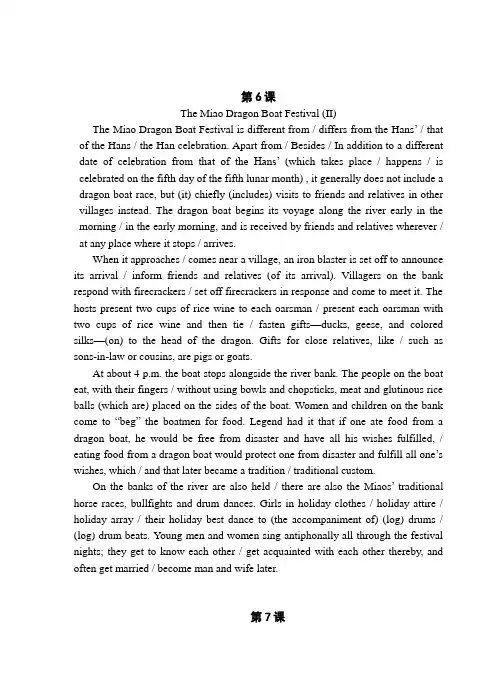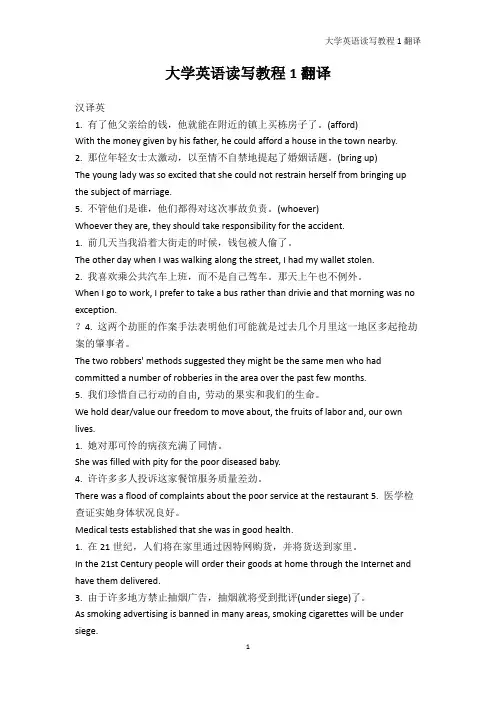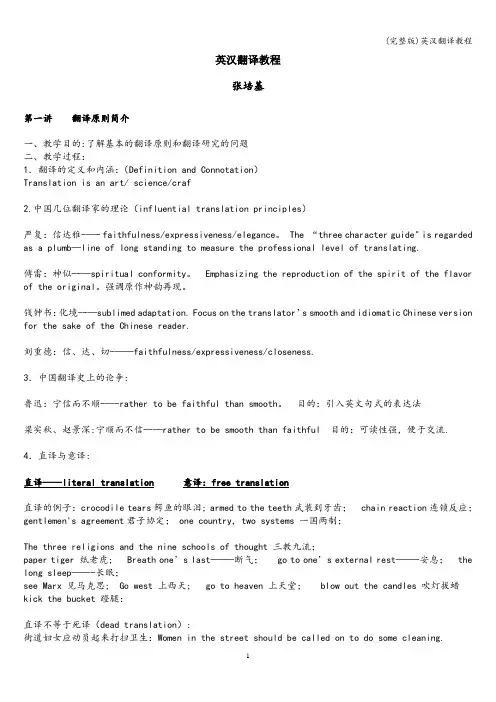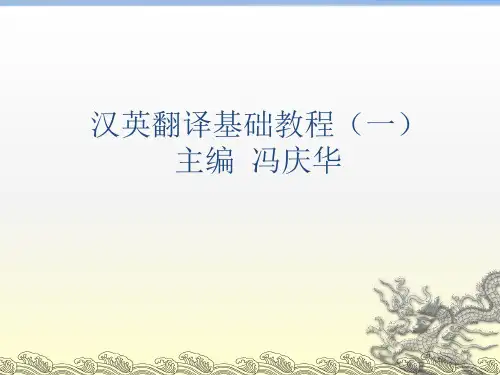汉英翻译教程1
英汉汉英翻译教程参考译文

第6课The Miao Dragon Boat Festival (II)The Miao Dragon Boat Festival is different from / differs from the Hans’ / that of the Hans / the Han celebration. Apart from / Besides / In addition to a different date of celebration from that of the Hans’ (which takes place / happens / is celebrated on the fifth day of the fifth lunar month) , it generally does not include a dragon boat race, but (it) chiefly (includes) visits to friends and relatives in other villages instead. The dragon boat begins its voyage along the river early in the morning / in the early morning, and is received by friends and relatives wherever / at any place where it stops / arrives.When it approaches / comes near a village, an iron blaster is set off to announce its arrival / inform friends and relatives (of its arrival). Villagers on the bank respond with firecrackers / set off firecrackers in response and come to meet it. The hosts present two cups of rice wine to each oarsman / present each oarsman with two cups of rice wine and then tie / fasten gifts—ducks, geese, and colored silks—(on) to the head of the dragon. Gifts for close relatives, like / such as sons-in-law or cousins, are pigs or goats.At about 4 p.m. the boat stops alongside the river bank. The people on the boat eat, with their fingers / without using bowls and chopsticks, meat and glutinous rice balls (which are) placed on the sides of the boat. Women and children on the bank come to “beg”the boatmen for food. Legend had it that if one ate food from a dragon boat, he would be free from disaster and have all his wishes fulfilled, / eating food from a dragon boat would protect one from disaster and fulfill all one’s wishes, which / and that later became a tradition / traditional custom.On the banks of the river are also held / there are also the Miaos’traditional horse races, bullfights and drum dances. Girls in holiday clothes / holiday attire / holiday array / their holiday best dance to (the accompaniment of) (log) drums / (log) drum beats. Young men and women sing antiphonally all through the festival nights; they get to know each other / get acquainted with each other thereby, and often get married / become man and wife later.第7课大本钟大本钟是伦敦最有名的地标之一,也是世界上最大的四钟面时钟之一。
院校资料-大学英语读写教程1翻译

大学英语读写教程1翻译汉译英1. 有了他父亲给的钱,他就能在附近的镇上买栋房子了。
(afford)With the money given by his father, he could afford a house in the town nearby.2. 那位年轻女士太激动,以至情不自禁地提起了婚姻话题。
(bring up)The young lady was so excited that she could not restrain herself from bringing up the subject of marriage.5. 不管他们是谁,他们都得对这次事故负责。
(whoever)Whoever they are, they should take responsibility for the accident.1. 前几天当我沿着大街走的时候,钱包被人偷了。
The other day when I was walking along the street, I had my wallet stolen.2. 我喜欢乘公共汽车上班,而不是自己驾车。
那天上午也不例外。
When I go to work, I prefer to take a bus rather than drivie and that morning was no exception.?4. 这两个劫匪的作案手法表明他们可能就是过去几个月里这一地区多起抢劫案的肇事者。
The two robbers' methods suggested they might be the same men who had committed a number of robberies in the area over the past few months.5. 我们珍惜自己行动的自由, 劳动的果实和我们的生命。
We hold dear/value our freedom to move about, the fruits of labor and, our own lives.1. 她对那可怜的病孩充满了同情。
英汉汉英翻译实训教程Chapter One Introduction to Translation

[点评] :
(1)译文1中,well-paved确是“铺设得很好的”,可是,一见到well或good
[译就译文成1“]:好铺”,设显得得很语言好贫的乏公。事路实经上过,英一语排里排的这整两洁个的词在,汉现译代时有的很房多屋译法,。 如:a这w些ell房-be屋ha坐ved落gi在rl“树举中止得。体的姑娘”
[译文]: 我们都会想念他的,但我们祝愿他退休后快乐,长寿。 4. He has enough money to burn.
[译文]: 他有花不完的钱。 5. Why did you set the wolf to keep the sheep?
[译文]: 你为什么要引狼入室?
General Introduction to Translation
expression)。
General Introduction to Translation
英汉汉英翻译实训教程
以作者和读者为取向
Chapter One
• 这类翻译标准或原则的共同特点是:翻译既要“忠实”又要 “通顺”,即译文必须既要考虑到原作者又要考虑到译文的 读者。
• 所谓忠实,首先指忠实于原作的内容。译者必须把原作的内 容完整而准确地表达出来,不得有任何篡改、歪曲、遗漏阉 割或任意增删的现象。其次还应保持原作的风格——即原作 的民族风格、时代风格、语体风格、作者个人的语言风格等。 译者对原作的风格不能任意破坏和改变,不能以译者的风格 代替原作的风格。
英汉汉英翻译实训教程
以作者和读者为取向
Chapter One
十八世纪末的英国学者亚历山大·泰特勒(Alexander Fraser Tytler,1747-1814)在《论翻译的原则》(Essay on the Principles of Translation)一书中提出了著名的翻译三 原则:
(完整版)英汉翻译教程

英汉翻译教程张培基第一讲翻译原则简介一、教学目的:了解基本的翻译原则和翻译研究的问题二、教学过程:1.翻译的定义和内涵:(Definition and Connotation)Translation is an art/ science/craf2.中国几位翻译家的理论(influential translation principles)严复:信达雅-—- faithfulness/expressiveness/elegance。
The “three character guide" is regarded as a plumb—line of long standing to measure the professional level of translating.傅雷:神似--—spiritual conformity。
Emphasizing the reproduction of the spirit of the flavor of the original。
强调原作神韵再现。
钱钟书:化境--—sublimed adaptation. Focus on the translator’s smooth and idiomatic Chinese version for the sake of the Chinese reader.刘重德:信、达、切-——faithfulness/expressiveness/closeness.3.中国翻译史上的论争:鲁迅:宁信而不顺-—-rather to be faithful than smooth。
目的:引入英文句式的表达法梁实秋、赵景深:宁顺而不信--—rather to be smooth than faithful 目的:可读性强,便于交流.4.直译与意译:直译—--literal translation意译:free translation直译的例子:crocodile tears鳄鱼的眼泪; armed to the teeth武装到牙齿; chain reaction连锁反应;gentlemen's agreement君子协定; one country, two systems 一国两制;The three religions and the nine schools of thought 三教九流;paper tiger 纸老虎; Breath one’s last——-断气; go to one’s external rest——-安息; the long sleep——-长眠;see Marx 见马克思; Go west 上西天; go to heaven 上天堂; blow out the candles 吹灯拔蜡kick the bucket 蹬腿:直译不等于死译(dead translation):街道妇女应动员起来打扫卫生:Women in the street should be called on to do some cleaning.“In the street" should be replaced by “in the community”.她一大早起床,进城,见到了她的公爹:She got up early, went to the town and saw her public father。
汉英翻译基础教程(课堂PPT)

正确译文 Artificial flower Lip-synch Counterfeit money Adulterated wine Pseudo-news Pseudo-science Vicious circle Malignant tumor Inflationary spiral
7
二、对等译法
例1. 他是在我不知道的情况下拿走它的。 He took it without my knowledge.
例2. 我们必须杜绝浪费现象。 We must put an end to waste
例3.周教授把自己的一生都献给了语言教学事
业Pr。ofessor Zhou devoted his whole life to language teaching.
正确译文 Chinese cabbage Password Mobile phone To fight a fire Puppy love Buy one, get one free. Acne Zoom lens Instant noodles Contact lens
4
原文 绿豆 卧室 试穿 食言 番茄酱 酸奶 戴绿帽子 黄色书籍 高等学校
9
3. 谚语: 趁热打铁 strike while the iron is hot. 滴水穿石 constant dropping wears the stone. 留得青山在,不怕没柴烧 As long as green hills
remain, there will never be a shortage of firewood. 路遥知马力,日久见人心 As distance tests a horse’s
14
增补介词
例1: 中国是一个幅员广大、历史悠久的大国。
汉英翻译(chapter one) 第一章 翻译的过程

2013年2月25日
一、翻译的过程
(一)理解阶段 1.语义分析 语义分析是语言分析的一个分支,说明处在 一定语境中,按照一定次序排列的词项之间 的语义关系,探索词项的意义。把握好原语 的全部意义,是翻译成效的关键。
琼州学院外国语学院
2
1)注意词的概念意义和关联意义。
琼州学院外国语学院 8
3.语用分析
语用分析,是通过语用学的思考,对语言的 交际意义进行综合分析的方法之一,旨在了 解和确定讲话人与所讲话语之间的关系,或 者说旨在把握语言符号与使用该语言符号的 人的关系。 这种关系常常表现为讲话人的感情、态度、 情绪、意念等。了解这一点对于翻译来说是 至关重要的。
琼州学院外国语学院
12
(二)表达阶段
1、直译(Literal Translation) 习语极富哲理、形象鲜明,深深植根于社会 习俗和文化传统之中,遇有原文用意独特而 汉语又无对应说法的谚语,可采用直译法。 但要注意的是,直译并非逐字对译,而是取 其题旨用意和比喻形象,兼顾原文修辞效果。 直译法如运用得当,可扩大读者的知识,丰 富汉语的表达能力。
11
琼州学院外国语学院
2)弄清讲话人的意图,进而决定表达方式。
① Harry is a professor, but can’t spell. 哈利是教授,奇怪的是不会拼写。 ② And you talked to him this way after all he had done for you. 人家帮了你那么多忙,你怎么竟这样跟人家 讲话呢?
① seat oneself in a wooden chair 坐在木椅里 ② accept a university chair 同意在大学里执教 ③ chair the board meeting 主持董事会 ④ condemned to the chair 被处电刑
英语汉译英 大学英语1新标准综合教程翻译
1.他们对业余剧社的介绍给苏菲留下了很深的印象,于是她就报了名。
Their introduction of Amateur Dramatics impressed Sophie so much that she sighed up for it .2.网络教育为全职人员提供了利用业余时间接受教育的机会。
Online education provides those who work full time with opportunities to receive further education in their spare time .3.刚上大学时,他不知道是否需要把老师讲的内容一字不落地都记下来。
When he first arrived at university , he was not sure whether he was supposed to scribble down every word out of the professor’s mouth .4.没有人觉察出他隐藏在笑容背后的绝望。
No one detects his despair well hidden behind his smile .5.有些学生能轻松自如地与陌生人交谈,可有些学生却很难做到这一点。
Some students are easy about talking with strangers , while some others find it hard to do so .1.他们这儿不卖薯条,如果你想吃,得去肯德基或麦当劳。
(serve)They don’t serve chips / French fries here. If you want them, you have to go to a KFC or McDonald’s.2.他捡起一个核桃,想用锤子把它砸开,可没想到却把它砸碎了。
(crack ; crush)He picked up a walnut and tried to crack it with a hammer , but instead he crushed it .3.当金子加热融化后,他们把金水倒进模子,铸成金条。
英汉汉英视译教程上篇英译汉第一单元 时间句视译-精选文档
第1单元 时间句视译(例句)
4. It was not until we got to be an arm’s distance from each other that I recognized it was my longlost elder brother. 【笔译】直到我们走到离彼此只有一臂之遥时, 我才认出对方是我失散已久的哥哥。
第1单元 时间句视译(例句)
〈译评〉笔译参考译文的语义逻辑略显平淡,视 译参考译文听着更具戏剧性,焦点更加 突出。文字表述与口头表述之间存在许 多规律性区别,英汉视译的转换终端是 口头表述形式。因此有时为了使缺乏听 觉趣味和视觉联想效果的书面语言听起 来更加生动、有趣,可以把原文里语境 语义的焦点适度放大或夸张, 甚至挪移, 使之更加凸显,以达到更佳的视听接收 效果。
第1单元 时间句视译(例句)
2. The bell had rung for the class before he could have his breakfast. 【笔译】 他还没来得及吃早饭,上课铃就响了。
【视译】 上课铃响了,可是他还没吃早饭。
第1单元 时间句视译(例句)
〈译评〉 本句中,由before 引导的时间状语从 句置于句末,这是英语常见的时间状 语从句形式,而中文的此类时间状语 更多见于句首。虽然笔译参考译文更 地道、生动,笔者还是建议学生更要 参考视译译文,因为视译译文更符合 “鱼贯而出”的视译规律。
第1单元 时间句视译
上篇 英译汉 英汉汉英视译教程
第1单元 时间句视译
无论何种形式的时间句,包括时间状语词组和时间状 语从句,英语时间句的特点都是时间修饰部分在句子中的 位置根据表达侧重的需要比汉语更加灵活多变,常见于句 首、句中和句末。而汉语时间句的时间修饰部分多见于句 首或句中,却鲜见于句末,这就造成英译汉时时间成分分 别在英汉句式结构中的时间和空间上的不对称,给即时口 译,尤其是同声翻译译员在瞬间构建译文逻辑时带来很大 的不便、干扰或障碍,从而减缓翻译效率,降低翻译质量, 甚至阻碍信息的顺畅传递。我们如果注意到英汉语句时间 修饰成分在句子结构位置上的特点与差异,经过专项翻译 练习,熟练掌握应对英汉时间句的转换技巧,便能够在语 句、语段或语篇翻译时达到迅速、自如、流畅、通顺的口 译较高境界。
汉译英教程
大学汉英翻译教程(王治奎)1.From English to Chinese (句子)55.I was only joking, but he took it to heart. Just as an old saying goes, “Acasual speaker’s remark may sound deliberate to a suspicious listener.”56.In blaming him for what had happened, you were indeed barking up thewrong tree. He had nothing whatever to do with the affair.57.She is not the kind of person to bear anyone a grudge. She is frank,broad-minded, and outspoken.58.Unique local creations are available in Xi’an, such as the three colored glazedpottery of the Tang Dynasty and terra-cotta figures.59.She couldn’t have come at a better time.60.They preach taking from others, whereas we advocate giving to others. Answers:1.我当时是说着玩儿的,他就认真了。
这不正应了那句话:“言者无心,听者有意”。
2.这件事你责怪他是找错了对象,他与此事毫无关系。
3.她不是那种小心眼儿。
她胸怀宽广、心直口快、光明磊落。
4.到西安你可以买兵马俑、唐三彩。
5.她来得正是时候。
6.他们讲索取,我们讲奉献。
2. From Chinese to English7.缘木求鱼8.大海捞针9.一箭之遥10.守口如瓶11.面如土色12.胆小如鼠13.一模一样14.蠢得像猪15.瓮中之鳖16.倔得像牛17.睡得死沉18.对牛弹琴19.一丘之貉20.掌上明珠21.像落汤鸡22.满腹文章23.聋得像石头24.像没头苍蝇25.无风不起浪26.挂羊头卖狗肉27.聚也不易,散也不易。
汉英翻译基础教程(课堂)_2023年学习资料
。2.成语:-博而不精extensive in knowledge but not expert in a y particular field-捕风捉影to clutch at shadows-看风使舵to wa ch how the wind blows and steer the rudder accordingl -脚踏实地with one's foot on the ground-狡兔三窟a cunning hare has three warrens-既往不咎let bygones be bygones-寄人篱下to l ve under somebody's roof-灰心丧气to lose heart-沧海一粟a drop in the ocean-冷眼旁观to watch on the side-line with a col stare
3、指称意义对应但忽略语言差异-原文-假朋友-正确译文-农民-Peasant-Farmer-宣传-Prop ganda-Popularize-物美价廉-Cheap and good-Economical and g od-你红光满面。-Your face is very red.-You look healthy and energetic.-他是个“气管炎”。-He suffers from tracheitis.-He i a hen-pecked man.
3.谚语:-趁热打铁strike while the iron is hot.-谪水穿石constant ropping wears the stone.-留得青山在,不怕没柴烧As long as green ills-remain,there will never be a shortage of firewoo .-路遥知马力,日久见人心As distance tests a horse's-strength,so ime reveals a person's heart.-他是不到黄河不死心。He would not top until he-reached the Yellow River-to give up unti all his-hope was gone.-世上无难事只怕有心人Where there is a wi l,there-is a way.
- 1、下载文档前请自行甄别文档内容的完整性,平台不提供额外的编辑、内容补充、找答案等附加服务。
- 2、"仅部分预览"的文档,不可在线预览部分如存在完整性等问题,可反馈申请退款(可完整预览的文档不适用该条件!)。
- 3、如文档侵犯您的权益,请联系客服反馈,我们会尽快为您处理(人工客服工作时间:9:00-18:30)。
《汉英翻译教程》-作者不详,在此致谢!第一章词的选择词义的正确选择首先取决于对原文的确切理解,而对原文词义的确切理解又取决于对原文上下文的推敲。
有些词看起来很简单,翻译时一下子就会想到常用的对应词。
但又是最常用的对应词却不能准确地表达原作的意思。
例如:还要努力读一点历史和小说。
We should also find time to read some history books and novels.这里“努力”一词理解为“挤出时间”是对的,如译为make an effort,则会使人误解为我们文化水平低,读历史和小说很费力。
再比如“水平”一词译成英语,不一定都是level, 要根据句子的含义确定译法。
1.他的英语水平比我的高。
He knows more English than I.这里,汉语“水平”一词虽未译出,但其以已含在句子中。
若照汉语字面应译成:The level of his English is higher than that of mine.就不符合英语表达习惯。
2.要奋发图强,把我军的军政素质提高到一个新的水平……。
We must work hard to r aise to a new height the military and political quality of our army…….这里“水平”指高度,故译作height,和动词搭配也比较顺。
3.各级领导干部必须提高领导水平。
Cadres at all levels should improve their art of leadership.这里的“领导水平”,实际上指领导能力、领导艺术、故译作art of leadership.以上的例子说明一个词的具体含义往往要结合上下文才能确定,在翻译的时候也只有结合上下文来考虑怎样处理这个词,才能译得准确。
因此在辨析词义和正确选词时可注意下列几种情况。
(一)注意词的广义与狭义英语中有不少同义词的词义有广、狭之区别,运用范围也就各不相同。
例如1.农业是国民经济的基础。
Agriculture is the foundation of the national economy.原文“农业”一词是广义,指一切农业经济(农、牧、林、渔),古译作agriculture。
但在“农林牧副渔结合的方针”中,农与林木副渔并立,是指耕作的农业,不是指整个农业经济,古译作farming。
整个词组应译为the principle of combining farming, forestry, animal husbandry, side-occupations and fishery.2.他从不喝酒。
He never touches wine.原文“酒”是指一切酒类,故译作wine。
但在“他不喝烈性酒”一句中,“酒”是狭义,是和淡性酒相对而言的,又需译作spirits。
(二)注意词义的强弱3.反动派的暴行激起了人民的极大愤怒。
The atrocities of the reactionaries roused the people to great indignation.这里的“愤怒”含义强烈,故在译文中选用了indignation,而不用anger.4.孙中山是个好人。
Dr. Sun Y et-sen was a man of integrity.如果译作a good man, 则与这位伟大的革命先行者的身份不相称。
(三)注意词义的褒贬由于人们对事物的态度不同,就会使用含有不同感情色彩的词,或肯定、赞扬、或否定、鄙视。
这种感情色彩应相应地在译文中表达出来,例如:5.我们应该从这里得出一条经验,就是不要被假象所迷惑。
We should draw a lesson here: Don’t be misled by false appearances.这里的“经验”不是成功的经验,而是从错误或失败中得出的经验,所以译文用了a lesson. 6.他们讲唯心论,我们讲唯物论。
They preach idealism whereas we advocate materialism.同是一个“讲”字,译文中一处用preach, 另一处用advocate,一褒一贬,反映了对两种世界观的不同态度。
(四)注意词的语体色彩同义词之间的差别,不仅表现在词义方面,而且也表现在语体色彩方面,例如7.别了,司徒雷登Farewell, Leighton Stuart!这是毛主席批评美国白皮书的一篇文章的标题,译文选用了farewell一词。
若用goodbye,则不能表现出原文所具有的特殊语气和轻蔑口吻。
8.禁止赌博。
Gambling is prohibited.原文“禁止”的语体色彩较为正式,故译作prohibit.9.这小伙子干活真冲。
This young fellow does his work with vim and vigour.这里的“真冲”是口语体,译者注意了这一点,相应地也用了口语词vim表达。
(五)注意词的政治含义10.“农民”peasant 和farmer都可以和汉语的“农民”或“农夫”相对应。
但是这个词的含义却有差别。
Farmer本指农场的经营者或所有者。
现在也可指以耕种为目的而租入土地的人。
Peasant指住在农村中的小农和以耕种土地为生的劳动者。
英美国家常用farmer指一般农民,而我们常用peasant指一般农民,并与landlord或worker相对而言。
11.“侵略”invasion 和aggression都是汉语“侵略”的对应词。
Invasion指军事入侵,而aggression的含义范围较广,可指政治、军事、经济、文化各方面。
12.“自主”autonomy和initiative都可以和汉语的“自主”相对应。
Autonomy指政治上有自治权利;initiative主要指思想上、行动上有主动性或独立性。
“独立自主”中的“自主”是指后一种意思,所以用initiative.13.打得赢就打,打不赢就走。
Fight when you can win, move away when you cannot.比较:Fight when we can win and run away when we cannot.(六)注意词的搭配汉英两种语言在长期使用过程中形成了各自的固定词组和搭配用法,翻译时必须注意两者的不同,不能把汉语词的搭配用法生搬硬套到英语译文中。
例如:战火扩大:the flames of war expand (应为spread)实现自给自足:achieve self-sufficiency (应为reach)学习知识:learn knowledge (应为acquire)违反他的意图:violate his intention (应为go against)严密控制:close control (应为strict/rigid)“啊,好票!”: Ah, good ticket! (应为seat)有资格打世界大战:qualified to fight a world war (应为capable of fighting/can afford to/powerful enough to)西方舆论纷纷预测:The public opinion in the West predicts one after another (应为The Western press has much to say in prediction)强硬政策:Strong policy (应为tough)搭配不单是逻辑上的问题,但大多数还是语言习惯问题。
我们要有意识地去熟悉哪些词经常连用,哪些词不能连用,否则就必然会出现“想当然”和“任意乱套”之类的错误。
不过,语言在发展,有些原来不能搭配的,现在可以了,因为有人在创新。
创新如果站得住脚,久而久之使用的人多了,就成为惯用的语言现象。
注意一些新的搭配,如:ground breaking theory(创新的理论)mental gymnastics (硬性推销)student friend(同窗学友)covert capability (搞情报的能力)第二章词的增补汉译英中的增词现象很多,尤其在译古代汉语或诗词时,由于汉语用词十分经济,译为英语时,如不增加必要的词语而逐字直译,便很令人费解。
如我们常引用的一句诗:“山雨欲来风满楼”,译成英语是:The wind swept through the tower heralds a rising storm in the mountain.原文只有七个字,而英译文则增加到十三个词。
为了保证译文语法结构的完整,可适当增补代词(或名词)、连词、介词、冠词等。
汉语里无主语的句子相当多。
英语则不同,句子一般都需要有主语。
所以在翻译这类无主语句子时有时要采用被动式或There be…结构等办法。
此外,还常常需要根据上下文的意思选择适当的代词(或名词)来补出主语。
例如(一)代词1.“凭舟极目望去,远处是黛色青山和五彩斑斓的田野。
”Leaning against the boat, you can see dark green mountains and gorgeous fields in the far distance. 2.接到你的来信,非常高兴。
I was very glad to have received your letter.物主代词在汉语里远不如英语利用得多。
在英语里凡说到一个人的器官和归他所有的或与它有关的事物时,总要在前面加上物主代词,例如:3.孩子们天天带午饭到学校去吃。
The children take their lunches to school every day.4.她用手蒙住脸,好像是为了保护眼睛。
She covered her face with her hand, as if to protect her eyes.汉语句子中,只要从上下文里能够看得清楚,作宾语的代词常常可以省掉。
可是英语就不行,凡及物动词都得有宾语。
因此汉译英时,经常要增补作宾语的代词。
例如:5.把这些故事看完以后,用你自己的话讲一遍。
After you have read these stories, tell them in your own words.6.请原谅,打断你一下。
Excuse me for interrupting you.(二)连词汉语中的词、词组、分句或句子之间的关系往往通过上下文及语序来表示,较少用连词。
英语通常需要用连词来表明词与词、词组与词组以及句与句的逻辑关系。
